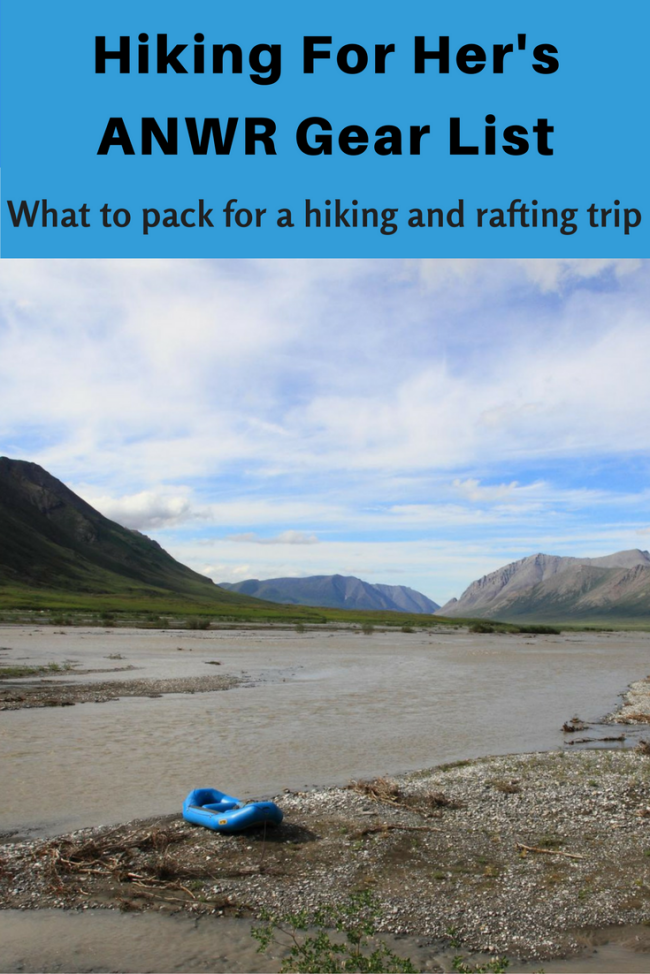
ANWR Gear List:
A Hiking Essential
By Diane Spicer
The Arctic National Wildlife Refuge (ANWR) in Alaska, USA is an exciting destination for hikers.
You can use my detailed ANWR gear list one of two ways:
- As an example of how thorough and thoughtful you should be when tackling a big backcountry trip like this one
- To prepare for your own ANWR (Alaska, USA) adventure
As with any hiking list, an ANWR gear list needs to be tightly focused for the changeable weather conditions as well as the changing terrain.
Here's a link to a description of my 2014 ANWR hiking and rafting trip. You know, in case you need a little motivation ;)
Now let's jump into the varied gear required for a trip that combines the best of both worlds: water and land exploration.
If you want to cut to the chase, drop down to the bottom of the page for a look at the specific clothing and gear I used on this trip.
ANWR gear list:
river gear
Clothing
The key to fun on the river is to think through what you need to maintain a high comfort level as you paddle.
Wear waterproof river pants and booties.
Alternatively (and maybe better):
- Wear river pants with neoprene socks attached; use running or walking shoes instead of booties (our experienced river guide did this; she had better traction on rocks and the shoes doubled as hiking gear).
In the booties/shoes, wear wool socks.
- These will get wet and dirty and crusted over after a few days, but will keep your feet as warm as possible.
- Here's my philosophy on hiking socks.
Bring a plastic bag to store them away from your other gear. If you’re lucky, sunshine and warm breezes will be abundant and the socks will dry out each evening.
- If they don't, no worries - they're going to get wet again, right?
I wore a pair of nylon hiking pants under the river pants.
- Another choice: leggings or running pants.
Be forewarned: these will get wet up to your knees, so be sure you have a dry pair to change into once you're off the river to maintain your body temperature.
Dry bags for your gear
Dry bags are durable waterproof sacks – don’t skimp on these because if they leak, you're going to stay wet for the entire trip.
You'll need two sizes:
- A big one for all of your gear including sleeping bag & tent
- A small one with a carabineer to clip to the raft for easy access during river time.
See below for what goes into the large dry bag (I recommend a backpack type with straps - makes it easier to pick up and transport).
In the small dry bag, store what you need on the river & at rest stops:
*snacks
*camera
*warm clothing: hat, gloves, vest, scarf, extra shirt. It’s tough to predict how cold you’ll be on the water because conditions change quickly.
Tip: The majority of your gear will be inaccessible, packed away in the raft, so be sure you toss this extra clothing into your dry bag before you hop into the raft each morning.
*sunscreen for face and hands
*toilet paper/wipes and a plastic bag to store used ones
*bug net for stops along the river.
Tip: We never needed bug repellant while paddling. However, we stopped along the river for rest breaks and sometimes hiked up onto a high point where bugs were abundant.
On the outside of this small dry bag, clip your water bottle/bladder. Keeping hydrated is important - be sure you have access to water in your bottles at all times.
Tip: Keep lip balm in the pocket of your river pants & apply it at every rest break. The dehydrating power of the wind and sun should never be underestimated. Dry, cracked lips are prone to infection.
Dressing smart for the river
I am not a very good thermal regulator, meaning that I’m often cold while others are not and vice versa.
So my ANWR gear list was all about staying warm or cool, depending on conditions.
Each morning before getting into the raft, I dressed in these layers and never found myself overdressed:
- sports bra
- sleeveless hiking shirt of wicking material to
keep me warm while sweating
- long sleeved bug shirt or wool shirt depending on
temperature
- fleece vest (or not, depending on conditions)
- windbreaker jacket (or not)
- waterproof shell (I wore mine every day – you never know when a wave will crash into the raft).
- river hat, over a thin nylon headband, and sometimes a scarf or bandanna around my neck to block a cool breeze
Tip: Wear a hat that can be tied down securely – the wind will rip it off your head. You also don’t want the sun beating down on the top of your head, hour after hour.
As we got closer to the Arctic Ocean, a pair of gloves (mine were fleece, with grips on the palms) completed my river fashion statement.
More tips on layering can be found here.
Eye protection is important
This Arctic environment holds many ironies, but the one I refer to here is the fact that while traveling on water, your body is drying out at an alarming pace from the sun, wind, and constant activity.
Tips to keep your eyes healthy:
- Wear
high quality UV lenses (not cheap sunglasses).
- Insert gel
eye drops before you go to sleep.
- Carry a bottle of liquid eye drops in a shirt pocket, to add moisture to your
eyes during river time.
- If you have light colored eyes, you might want to consider glacier glasses to reduce the UV and wind exposure even further. (Email me for details on the corneal abrasions I suffered on this trip.)
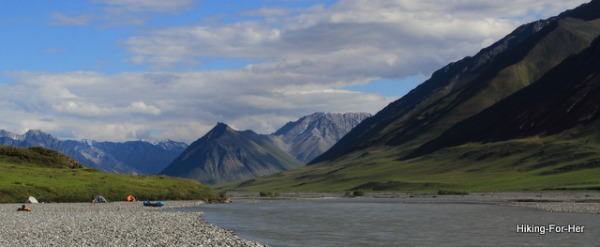 Camping on a gravel bar, Canning River, ANWR Alaska, USA
Camping on a gravel bar, Canning River, ANWR Alaska, USA
ANWR gear list:
camping gear
Except for the tent & sleeping bag, all of the necessary camping gear was provided by the outfitter:
Stove with fuel
Bear canisters (twist top, transparent, lightweight)
Bug tent as a mess hall (wind permitting) – a literal sanity saver!
Hand sanitizer/soap
Scrubbie & dish soap
Mess kit for each person: bowl, mug, spork or equivalent
Navigation and communication equipment:
- Satellite phone & extra battery, GPS, maps, pen and paper
Tent with footprint & fly, extra stakes, space blanket for interior floor on wet or cold nights
Tip: If you sign up for a guided trip, be sure you are given a specific ANWR gear list, rather than a generic list.
Check the list for what you need to bring, versus what the guides will supply for you.
ANWR gear list:
personal hiking stuff
Every hiker has a different mix of gear she considers to be essential for safety, comfort and personal reasons.
Here's what was on my ANWR gear list.
Hiking equipment
Poles: I brought 2 poles, which were unnecessary for the terrain. If I had to do it over, I wouldn’t bring poles. They took up room in my dry bag and were just one more thing to keep track of.
However, if we had made time to go up on higher peaks, I would have welcomed my poles for stability and balance. Read why here.
Here's an example of when your ANWR gear list will become individualized.
Footwear: I also might not bring hiking boots to ANWR!
Two options:
- If you wear walking shoes in the river, just use those.
- Or wear sturdy trail shoes on your trip up to Fairbanks and use those for hiking.
- And don’t bother bringing river sandals – they weren’t used.
Crocs might be a good idea for camp shoes/exploring. I don’t think they’re a good substitute for river shoes, though – I watched one float away without the owner being aware that it had slipped off (not to worry, we rescued it in time).
Pack: I brought a 24 liter woman’s Osprey daypack, which was used as carry on luggage on the plane trip up to Fairbanks. I also used it for dayhiking.
I recommend a pack with several outside pockets to make sunscreen, bug net, and sunglasses easily accessible.
My pack has an attached rain cover, which I highly recommend.
- Even if it’s not raining, chances are you’re going to put the pack down on a wet/damp surface and the rain cover keeps everything in the pack drier.
For more details on the best hiking gear, go here.
Hiking clothing layers
Think in fast drying, wicking/vented layers when you're drafting your ANWR gear list.
Over 24 hours you
might find yourself:
- cool at breakfast,
- chilled for the first hour on the river,
- blazing hot while resting on
a gravel bar after lunch,
- soggy after a rain squall,
- and then comfortably warm in your sleeping bag as you drift off to sleep.
So you're going to do what every sensible hiker does: include clothing layers on your ANWR gear list.
Here's what worked for me:
Pants: 2 pairs. You will wear one pair under your river pants, or bring tights, running pants, or long johns for that purpose.
I prefer to sleep in long johns so I wore hiking pants on the river. The second pair was to change into after we came off the river –you can get really chilled and spend a lot of calories warming back up if you don’t ditch your wet clothing.
One pair of pants was impregnated with DEET. And they stood up to all of the abrasion and rough usage I threw at them on this trip - so I'd purchase this brand again.
I was told that soaking your clothes in DEET can be achieved at home, if you buy veterinarian strength DEET (used for horses), dilute it to 1/6th strength, and soak shirts/pants overnight. I would imagine that air drying would follow the immersion.
Shirts: I used a wicking sleeveless top as a base layer on the river, a short sleeved wicking shirt to wear while hiking, and a long sleeved SmartWool shirt for cooler days.
In addition, I had an extra short sleeved top to sleep in and a long sleeved bug shirt that I wore while hiking or making camp to keep the mosquitoes on my arms and back from biting.
One more layer on top: a fleece vest that was cozy and had a stand up collar to help keep my neck warm and bug free, both on or off the river. If you’re warmer blooded by nature, maybe you can omit the vest.
Socks: At least 3 pairs, 1 of which becomes your nasty river socks inside your booties (sometimes got them to dry overnight but they were pretty smelly by the end), the rest for hiking or tent time.
I hike with thin silk or nylon liners, so I had 2 pair of those along, too. If I omit the hiking boots, I'd omit these liners.
Hats: Bring a variety, to keep up with changing weather conditions.
I had:
- a baseball cap for hiking (brim keeps sun out of eyes &
bugs off my head),
- a lightweight wool cap with flaps for sitting around at camp,
- a
lightweight nylon headband to put under my river hat to keep wind out of my
ears,
- a wide brimmed river hat with adjustable cord to cinch down tightly,
- and a fleece cap just because!
For more detailed information on clothing choices, go here.
Underwear: The basic idea is to keep yourself reasonably clean.
There are 2 ways to go.
Option 1: Bring half as much underwear as the days of the trip and turn each pair inside out, thus guaranteeing you relatively clean underwear every day of the trip.
Option 2: Bring only a few pairs of underwear and use thin disposable liners which you put into a dedicated plastic bag at the end of each day and pack out for disposal at home.
I brought 3 sports bras – they get really sweaty and it’s nice to have one on, one you just washed drying out in your tent, and one stashed away in case you get wet.
NOTE: Some women omit underwear entirely! Chafing and abrasion are not fun, however.
Be forewarned. And bring some Body Glide.
For more information on choosing hiking undies, read this.
Female hiking hygiene tips are here.
Protection and hygiene
Jackets: Think carefully here. You don’t want bulk, but you do want to be warm and dry.
Which of your hiking jackets has earned a place on your ANWR gear list?
As an example, I brought an old down jacket that was easy to wad up in my stuff sack but it wasn’t waterproof, so I used it mostly as a pillow with an occasional foray in dry weather.
- In retrospect, I probably didn't need it until we got close to the Arctic Ocean.
In addition, I wore a windbreaker jacket that was water resistant, and found it invaluable as a 3rd layer on the river as we approached the cold ocean air.
But my most valuable jacket was a waterproof shell that went over the top of all of my layers.
Here’s what I’d like to urge you consider: buy a jacket that covers your fanny because it keeps you warmer and drier if you’re sitting on gravel or wet vegetation (or in a raft).
Also, exterior bilateral pockets are essential for stowing Kleenex, lip balm, gloves, and other necessities.
And a hood that cinches down can come in mighty handy when the wind picks up.
Bug protection: The only parts of my body that were exposed to mosquitoes on most days were my hands, face, and neck.
A simple bug net worn over my brimmed hat took care of the face & neck, and mosquito repellent took care of my hands.
I used the nasty DEET full strength on my hands, but also ran an experiment with a geraniol/eucalyptus product and was delighted at how well it worked. It had to be reapplied much more frequently than the DEET, but hey! It worked.
One drawback to both products: strong odor, which is a bad idea in bear country. I wiped off my hands with a moist towel just before bedtime.
Bandanna: I’m a big believer in bandanas.
On this trip, I used one as a face towel, a neck warmer, an eye compress, and a handkerchief when my facial tissues ran out.
Hygiene note: Wash your bandana out each night with a bit of soap and water, and then hang it up to air dry in the tent.
Or tie it to your dry bag in the raft while you’re paddling and let the river wind dry it out.
 Toasty warm even in the rain at midnight on the 4th of July, thanks to my ANWR gear list.
Toasty warm even in the rain at midnight on the 4th of July, thanks to my ANWR gear list.
Strategies for comfort
on the ANWR gear list
Face/teeth hygiene kit
Keep all of your soaps, lotions and goops together and put them into a bear canister at night, even if they are marketed as unscented.
The more I read about brown bear attacks, the less inclined I am to bring toothpaste into the back country. However, floss and a brand new travel toothbrush will be coming along with me & used daily.
To keep face and neck clean, consider bringing premoistened wipes/towelettes (as long as they don’t have a strong odor) which go into a ziplock once they’re used & into the bear canister for storage.
I brought a small amount of mild unscented soap (Dr. Bronners) and a backpacking towel (chamois, fast drying like this one) to wash up with once a day, followed by face lotion which felt great on my wind/sunburned skin.
Keep it simple: Be able to put your hands on this kit quickly by keeping it in one bag, in bombproof containers (you don’t want the caps to pop off or leak – messy, sticky, irritating & a waste of precious resources when you’re in the backcountry).
Tip: Apply lip balm liberally, and consider putting petroleum jelly or other waterproof barrier material into the outer edges of your nostrils.
- My shriveled up nasal and oral mucus membranes led to a bacterial infection, nosebleed, and very sore lips and nose - all of which could have been prevented by lubricants.
- Lesson learned the hard way! So be forewarned, and be really thorough with your ANWR gear list.
Hair sanity kit
My hair is long, so I need scrunchies/hair ties/clips to get it up and out of the way while paddling and hiking.
I brought a small amount of unscented shampoo and used it every 3rd day, weather permitting.
However, if you have short hair, you might not need to wash your hair if you can keep it off your face with bands, ties, pins or whatever works for you.
I bought a travel brush ($1 at Target, comes with a mirror which you might or might not want to use!!) and would use it to work out the daily knots in my hair whenever the wind wasn’t blowing hard.
Braids, buns, ponytails – it’s all good.
The best tip? Wear a hat – constantly.
- It keeps sun off your face (UV radiation = wrinkles, cataracts, burns) and hides hair disasters.
- Here are the details of my hiking hat collection.
Personal hygiene kit
I used baby wipes rather than toilet paper, putting used wipes into a ziplock bag for disposal once I returned to "civilization". Used Kleenex also went into this bag.
Wondering why not into the camp fire each evening? In this region there are no trees!
If you’re going to have a menstrual period during the trip, you will need to bring adequate supplies and designate more ziplocks for these used items.
I don’t use deodorant/antiperspirant on outdoor trips because I want to clean out my lymph system – sweating is actually a good idea!
And washing up once a day takes care of most "offensive" body odors. C'mon - you're a nature girl, aren't you?
If you'd like to build a personal hygiene kit, read this.
Comfortable sitting
If you have back issues or not much padding on your behind, consider bringing a camp chair that doubles as a sleeping pad.
You can purchase butt sized ThermaRest inflatable sitting cushions like this one, or just sit on the ground (this gets old quickly, I'm here to tell ya).
Another idea: Bring your oldest foam pad to kneel and sit on, knowing that it will get gouged by rocks and dirtier than you can believe.
We sat on bear canisters and also used them as makeshift tables, but they weren’t at all comfortable so I can't recommend them for sitting.
Sleeping comfort
Your sleep system should be lightweight but completely trustworthy in terms of thermal comfort.
Most women will admit to sleeping “colder” than male companions, so pay attention to your head and neck (don a fleece hat and scarf) as well as your back when selecting a sleeping bag and pad.
I think my traditional ThermaRest self inflating pad has come along on the last trip - it’s awkward to get it rolled up in the morning, it’s big and unwieldy in my dry bag, and there are better ideas currently on the market.
However, I love its comfort and insulating abilities.
Even when the bottom got wet (sudden deluge, setting up tent quickly, standing water in the tent –it will happen at least once each trip), it kept me warm.
So I'll upgrade to a lighter, slimmer version, like this one.
Ear care
Ear plugs are essential on bush plane rides which don’t provide head sets (noise reducing ear muffs with microphones for communication between pilot and passengers).
They also are a great help for tuning out background noises (rushing water, roaring wind, rustling leaves, marauding ground critters, snoring tent partners) so you can fall asleep.
I also recommend a lightweight headband to block wind from whistling in your ears while hiking or paddling, especially if you're prone to earaches.
Hydration strategies
This is the most serious advice I can give you, and the one you might be most inclined to blow off:
Bring a water bottle and stay well hydrated.
How?
The river water is there for the taking, so fill up your water bottle frequently, and sip it at every rest stop regardless of your thirst signals (or lack of them).
These collapsible bottles are so handy.
So are Nalgene bottles with a loop on the cap, for clipping to a carabiner and then to the raft.
At your evening camp, sit down and drink a liter of water.
No joke!
You don’t realize how dehydrating the constant sun and wind are, until you see how concentrated your urine is (dark smelly yellow) or your head starts pounding (dehydration headache).
Tip: In ANWR, it never gets dark in the summer so your midnight pee trips will be easy.
General health tips
Bring some extra vitamins and minerals!
If you take daily supplements, be sure you have enough rationed for each day, with an extra cushion in case of fatigue or illness.
Store them in double plastic bags, because they will dissolve into a mushy paste when they get wet.
Extra vitamin C gives your immune system a boost. Bring 1 gram tablets. This is important when fresh fruit is absent from your river diet.
Electrolytes are really important when you’re physically active in the wind and sun for days on end.
- I use Ultima Replenisher (nonGMO, gluten free, vegan) electrolytes, but Emergen-C might be something that works for you (it’s cheaper and comes in more flavors, plus it gives you that extra vitamin C mentioned above).
NOTE: Both of these make great warm beverages to sip while you’re waiting for dinner, and your muscles will thank you the next day on the river/hike. It’s also another way to tempt you into consuming water because it adds a bit of zing to the water bottle!
However, you will need to rinse out your bottle every day if you don’t want weird “scunge” to start growing in it.
A personal first aid kit is a good idea because you don't know ahead of time what will be provided.
I stock mine with the following:
- plain old table salt (for salt water gargles in
case of sore throat),
- eye drops to cleanse and lubricate tired eyes,
- tea tree
oil for skin blisters or eruptions,
- Ibuprofen for sore muscles after a long day
of paddling or hiking,
- aspirin in case of heart attack (clot prevention or
reversal),
- Nyquil or equivalent to knock myself out if fever or inflammation strikes and I really need to rest.
This is in addition to the expected assortment of band aids and antibiotic cream, a few gauze squares & tape, tweezers, scissors, needle and thread, & ace bandage.
Bring your joy!
What brings you the utmost happiness while you’re on a trip like this?
My husband loves taking photos, and wanders the landscape looking for great shots, so he brings lots of batteries even though they’re heavy.
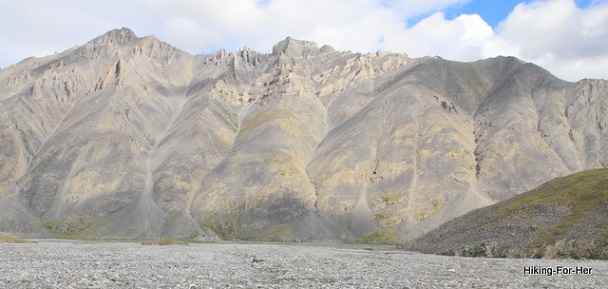 Nonstop sunshine in the Arctic in July!
Nonstop sunshine in the Arctic in July!
For me, I enjoy looking at the flora and comparing it the Pacific NW plants that I know and love.
I also love looking for fossils, animal tracks and bones, or signs of wildlife traffic (game trails, chewed bark, hairs on tree branches, bent twigs on a game run, fox tracks on a sand bar, dug out dens).
- Then I sit with my hiking journal and make notes and observations.
This naturalist habit costs nothing in terms of weight or equipment but satisfies something in my soul.
Other folks love to read a favorite book, or look up things in guide books, or take a blissful nap in the sun.
Be sure you have what you need for your “quotients of joy” moments, weight be damned! After all, the river is doing all of the heavy lifting ;)
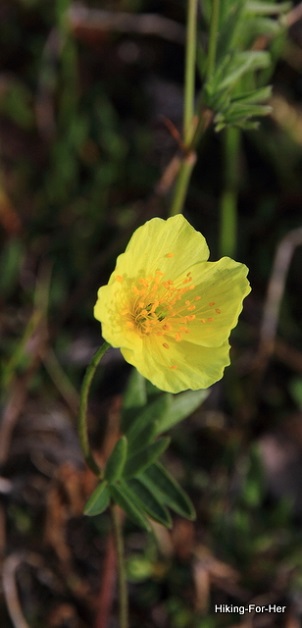 Delicate yellow arctic poppy
Delicate yellow arctic poppy
Food
Your body will be working hard on an ANWR trip, so give it lots of fuel.
I have some tips for you to get up to speed on hiking nutrition.
I'll share my own dietary experience here, to give you an idea of what to do if you require specific foods.
I have several food sensitivities, which means I can’t eat standard backcountry fare (pasta based dehydrated entrées with wheat or tomatoes, wheat bread or crackers, cheese, citrus).
Instead, I bookend my day with 2 lightweight but hearty staples: doctored up oatmeal (trail mix, flax, jam) for breakfast, with a heaping portion of high protein quinoa for dinner.
Lunch is always nut butters, dried fruit, a handful of chocolate, and any carbohydrate I can manage: rice crackers, gluten free bread (none of which travels well), or granola.
- Carbohydrates are the key to great hiking energy, right?
Monotony is what works best for my gut.
I’ve also learned that it’s important for my digestive system to begin transitioning over to dry backcountry food before I leave for the trip.
- I start decreasing my consumption of fresh vegetables and salads (huge portions of my normal daily diet), and begin to get used to drier, more dense foods (yet another reason to increase your water intake during the trip).
If your digestive system is bombproof, you have my admiration!
- You can wolf down salami & cheese, heaping bowls of pasta, tortillas smothered in pesto, instant potatoes and gravy, and all sorts of treats I had to pass up.
Mental preparation
While making an ANWR gear list is important, it's even more important to prepare yourself mentally for the rigors of a trip like this.
- Your brain is a vital part of your gear.
- Use it!
However, your brain will defeat you much more quickly than poor weather or adverse travel conditions.
Who’s in charge, your brain or your body?
Your brain!
It is my firm belief that in the outdoors, attitude is everything.
Example: If the swarming bugs defeat you, examine your attitude toward them. They live here, you're just visiting. Change your attitude & admire their cunning, their persistence, their lust for your blood!
Patience is the key to a great trip.
You must be able to let go of your expectations of when and how things “should” happen in order to enjoy the moment – even when that moment includes driving rain or swarms of mosquitoes.
There’s nowhere else to be but RIGHT HERE, RIGHT NOW.
Stop thinking!
- If you can, eliminate all of the judgments
you make (“The water is too cold.” “The sun is too bright.” “The bugs are
bothersome.”).
- Don’t paint a picture with all of these words.
- Instead, get out of your own way and be surprised by the peacefulness of an empty mind.
One final tip: Surrender to the trip leader’s leadership (unless things are going seriously wrong – your gut will tell you when that happens).
- You might know a faster or better way to do something, but you also might learn something if you hold your tongue and observe the leader.
- It also makes for more pleasant group dynamics.
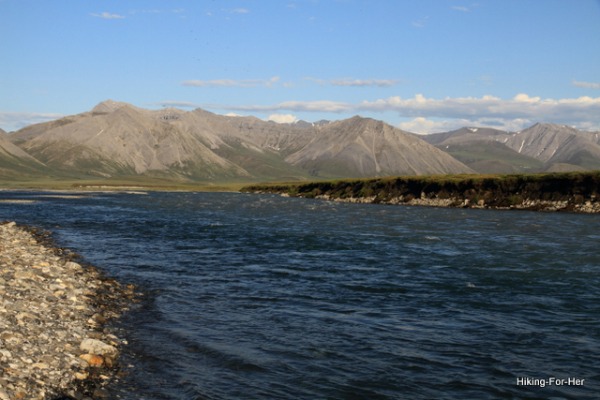 The mighty Canning River, ANWR, Alaska USA
The mighty Canning River, ANWR, Alaska USA
ANWR gear list finale
That about sums up my ANWR gear list.
Take what resonates, ignore the rest!
Let me know if you have questions, I'd be happy to help you get ready for a big adventure like an ANWR hiking and rafting trip.
Here's an easy way to see some of the gear that was on my ANWR gear list.
If you purchase gear through these links, Hiking For Her receives a small percentage of your purchase price.
But you pay nothing extra for your gear!
Sounds like a win-win, doesn't it?
Home page > ANWR Hiking and Rafting >
ANWR Gear List
|
I get emails all the time about what I wear, eat, carry and love to use on the trail. That's
why I provide affiliate links to you: the best gear that I use myself and have seen used by other hikers is instantly
available for your consideration, and the gear company sends a few
pennies per dollar to this reader-supported hiking website. There is no added cost to you! Everyone ends up a winner: Great gear for you, strong gear companies, and more free hiking tips for everyone. Thanks very much for your support. It's warmly and sincerely appreciated. It also helps send these hiking tips to all your virtual trail buddies around the globe. |
 |
